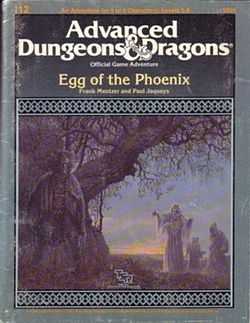Egg of the Phoenix
 | |
| Code | I12 |
|---|---|
| Rules required | AD&D (1st Edition) |
| Character levels | 5 - 9 |
| Campaign setting | Generic |
| Authors | Frank Mentzer and Paul Jaquays |
| First published | 1987 |
| Linked modules | |
| I1, I2, I3, I4, I5, I6, I7, I8, I9, I10, I11, I12, I13, I14 | |
Egg of the Phoenix is an adventure module published in 1987 for the Advanced Dungeons & Dragons fantasy role-playing game.
Plot summary
In Egg of the Phoenix, the player characters (PCs) start off investigating a slaver ring, and must ultimately work to save the entire land of New Empyrea from destruction by the lords of Elemental Evil.[1] The module includes dungeons, wilderness adventures, time travel, and extraplanar journeys.[1]
Publication history
I12 Egg of the Phoenix was designed by Frank Mentzer, with additional design, development, and editing by Paul Jaquays.[2] The module's cover is by Keith Parkinson, and was published by TSR in 1987 as an eighty page book, a twenty page booklet, and an unattached outer folder.[1] The booklet contains a map and pre-generated PCs.[2] This module was a linkage of three formerly unlinked scenarios originally published in the RPGA modules R1 through R4.[1]
Reception
Ken Rolston reviewed Egg of the Phoenix for Dragon magazine No. 133.[2] He felt that the first three scenarios were "original, challenging, and entertaining, particularly in their exploitation of the peculiar logic of the AD&D game universe", but had reservations about the final scenario, which "despite having a plausible game rationale and logical self-consistency, strikes me as gross and overly busy rather than lean and elegant".[2] He felt that assembling these tournament scenarios into an epic campaign was not very successful, because Mentzer had not designed them as a sequence, and they originally had nothing to do with one another. He said, "the narrative frame isn't particularly persuasive, nor do the supplemental encounters or transitions match the tone and theme of Mentzer's original tournament designs", and "the introductory motivations for involving the PCs in the epic quest are rather arbitrary".[2] Rolston also noted some careless production errors, such as a number of typos in the first few pages, and that the text refers to the map book as a twenty page center pullout. Despite his complaints that the campaign frame and the production quality were not satisfactory, Rolston concluded by saying: "There's some very good stuff in here: nine sessions or more of solid and occasionally brilliant material. The tournament-based adventures may be the strongest of Mentzer's peculiarly original AD&D game designs."[2]
References
| ||||||||||||||||||||||||||||||||||||||||||||||||||||||||||||||||||||||||||||||||||||||||||||||||||||||||||||||||||||||||||||||||||||||||||||||||||||||||||||||||||||||||||||||||||||||||||